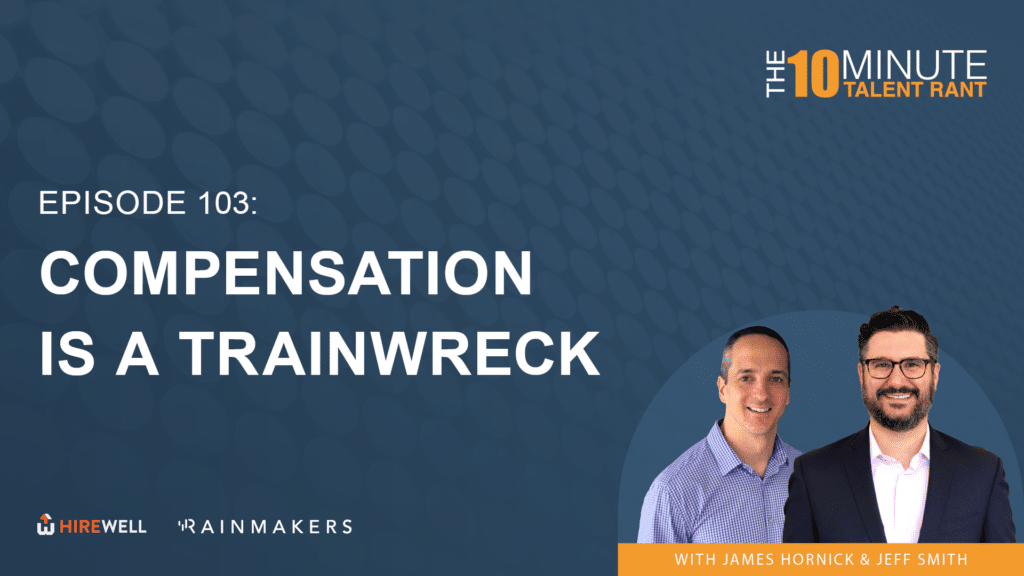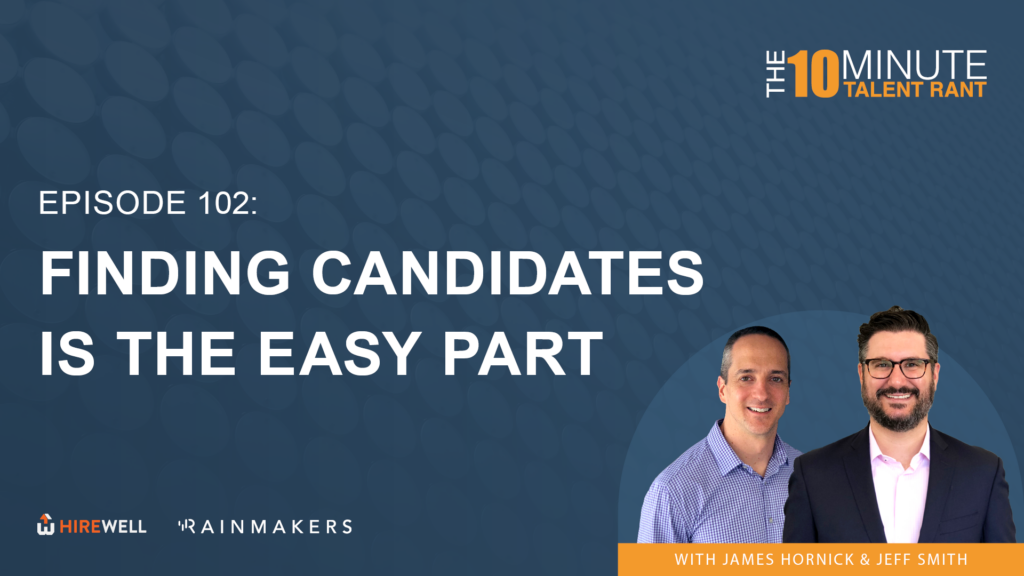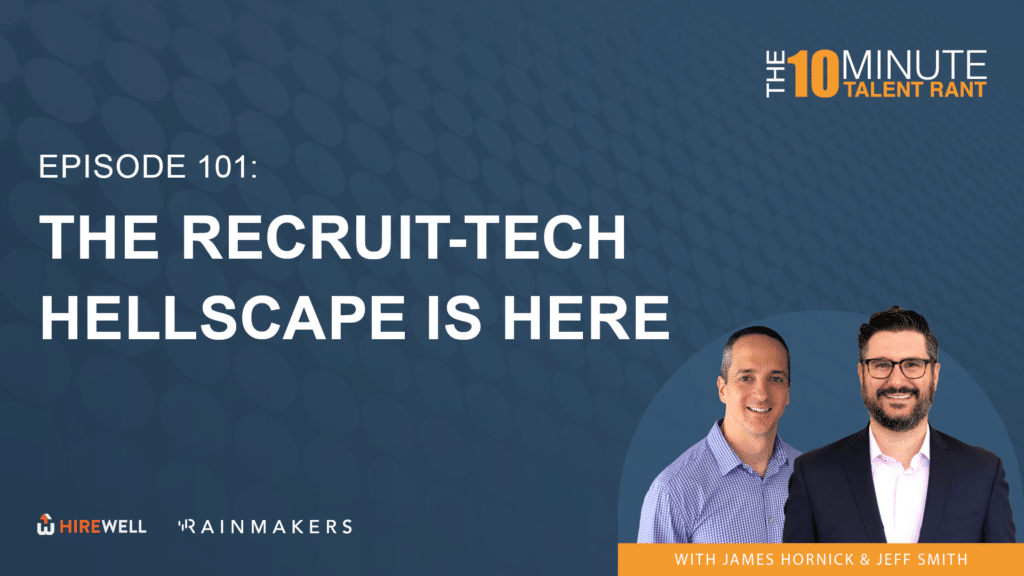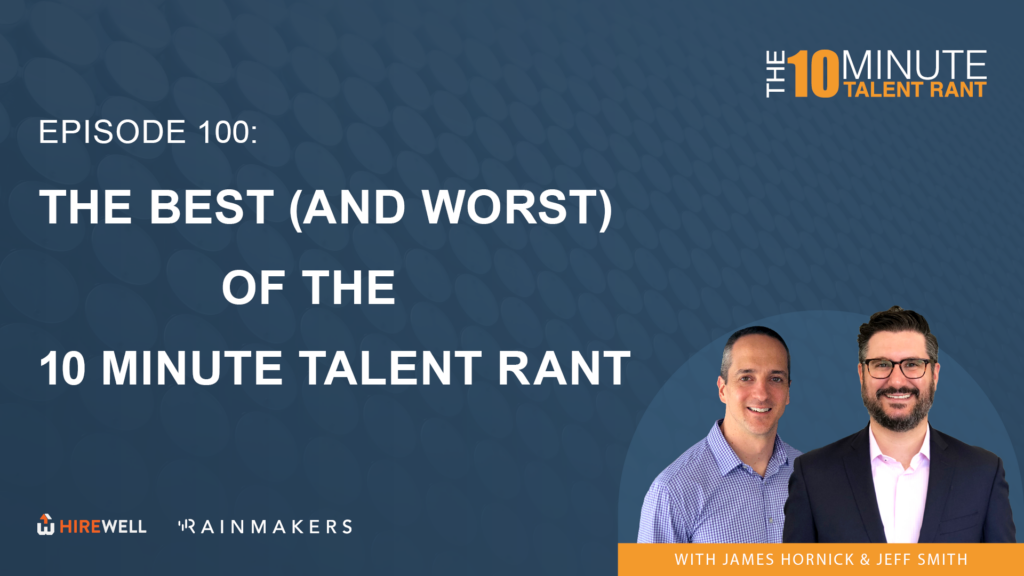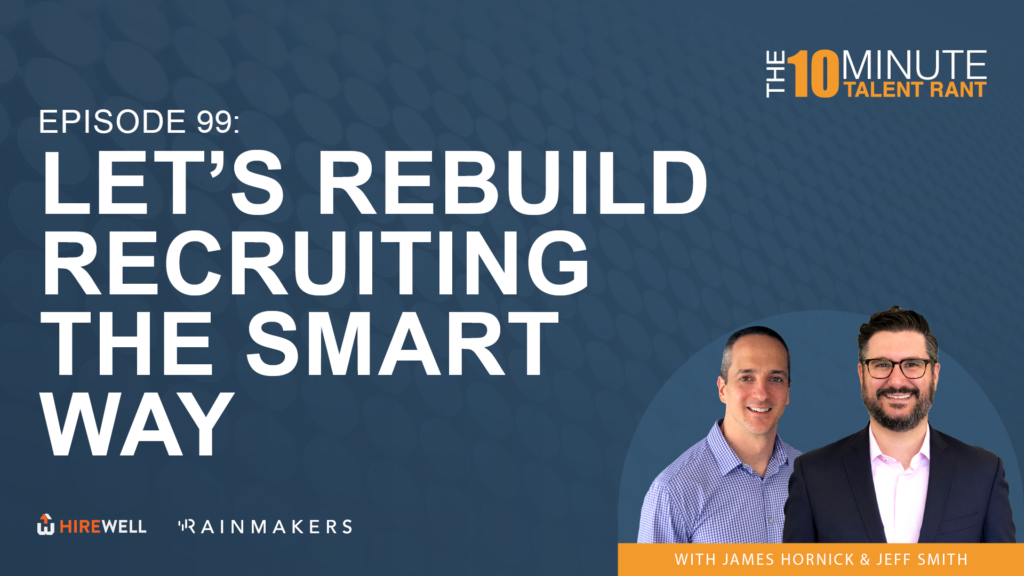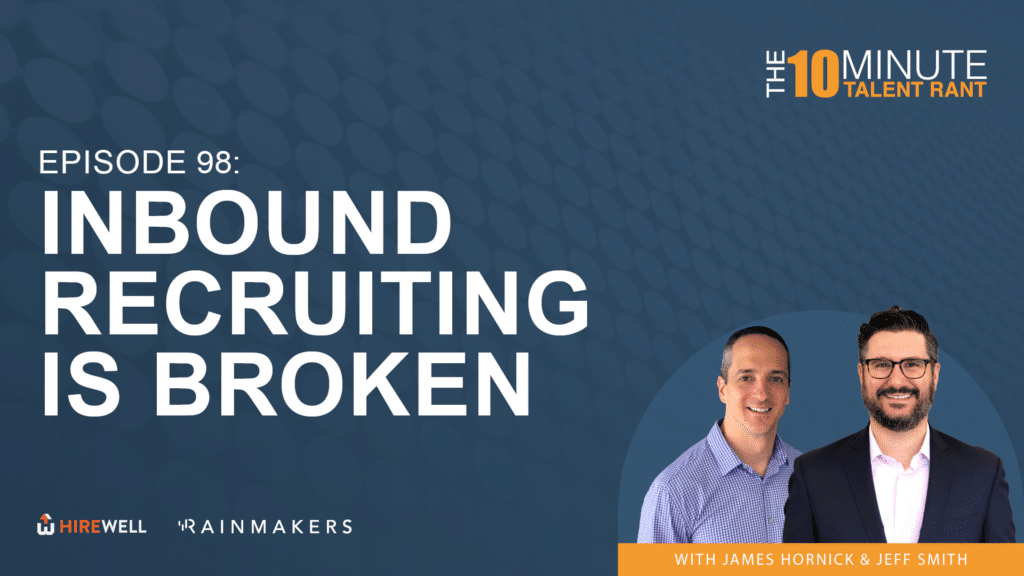The 10 Minute Talent Rant is live. I’m James Hornick joined by Jeff Smith and we are on the clock. The 10 Minute Talent Rant is our ongoing series where we break down things that are broken in the talent acquisition and hiring space. Maybe even pitch a solution or two, probably not today. Before we dig in, all of our content can be found at talentinsights.hirewell.com.
There are- I mean, there are takeaways. Yeah, there are takeaways. Yeah, you’re correct. There is one distinct takeaway here today. This week’s topic, and we actually do have a time crunch on today, Jeff tells me he has something in 11 minutes, so let’s really blow through it. Episode 97, we’re getting up there.
Employment data analysis is a dumpster fire. I love it. Garbage to trash to dumpster fire. It’s a great, it’s such a great progression. Yeah. So- our cynicism dialed up, damn. Long before the rallying cries of fake news in this country and anti mainstream media sentiment and everything else. Like I’ve always hated the financial media specifically.
A real specific about the financial media. So if you’re not aware, the people who are paid to actually talk about the financial markets, and this gets into labor markets because it’s all kind of related- they’re not actually allowed to invest in the financial markets. Meaning, if you ever made a single trade in your life, you actually know more about trading than anyone on CNBC because they’ve never actually done it.
And whatever your skill set is, like, I worry about the false correlations these people make all the time. Like, Dylan Radigan, he was a long time guy on CNBC. He’s kind of independent now and whatnot. He even admitted to back in the day, anytime the market was down, they would just look at like okay, what’s happening in the news?
Okay, that’s why it’s down. Or they’d pull out something out of their desk and be like okay, we just got to come up with a headline for this because no one has any idea. And no one can prove that they’re right or wrong, that everything happens and changes so fast. They just take any story and run with it and try to make some sort of reason why things are happening when no one actually knows.
I know you hated it. I always- I was like, “but Kramer said” and you’re like, dude, shut up. He doesn’t know anything. Yeah. He’s an idiot. I mean, the wrongness of all these talking heads, it- I mean, to your point, it is all tied to the labor market. Yeah. The more doom and gloom and you know, all of this stuff by design, more companies get super gun shy about investing in human capital.
So it slows down by hiring and those sorts of statistics. It also gives all of these places, these companies, an easy way to skimp out, right? Like to say, “Yeah, we’re not going to invest in payroll. We’re going to wait it out a little bit longer” which obviously has a lot of real world consequences. Yeah.
And the key thing I want to talk about today with the headline here is like, and this is what I think people might be shocked by. It’s not the data that sucks. The data is usually pretty damn accurate. It’s the armchair analysis of the data that’s become an absolute train wreck. I mean, not just from the mainstream media, I mean, from the anti mainstream media, people on Twitter and everyone else kind of following along at home.
We actually get pretty good data from the government on a consistent basis. And then when there’s flaws, I can explain why some of them has happened, but it just gets in the hands of too many idiots. Yeah, so before everyone’s like, yes, James, Jeff, the media is so terrible. And for all you liberals out there, all these conspiracy theorists are so terrible-
like, stop. Enough. We’re not going to go full flamethrower on all of this. We do have beef with both sides of that coverage. And then more granularly how it affects like the employment and labor markets. But you’ve been on me for many years to see higher quality information from more trusted resources.
So what do you have for me and all the other audience? So what spun this? Because this is probably the third thing that’s happened in like the last month. I saw this article from USA today- USA two days ago, publish a story, this on the 16th, September 16th. The title “Wages adjusted for inflation are falling for new hires and signs of slowing job market”.
Now, I’ll try to read this out verbatim here. Actually, I have it. If you need a quote unquote, I’m quoting this USA Today article. “If you need further proof that the nation’s formerly sizzling job market has gone cold, look for what has been perhaps the hottest part of the post pandemic hiring frenzy. Pay for newly hired workers.
After adjusting for inflation, average wages for new hires fell 1.5% over the 12 months ending July”. July. Keep that part in mind. 12 months ending July. LeBron GIF. Yeah. From $23.85 cents an hour to $23.51, the largest such decline a decade according to analysis of the Labor Department figures by W.E Upjohn Institute Up for Employment research.
I have no idea who they are. By contrast, inflation adjusted earnings for typical workers, staying in their jobs rose 2.3% for the same period as their study shows. Now, I’m pointing out the one thing I liked that they differentiated the difference between new higher wages and existing employee wages
because most people screw that up. And anytime you get analysis from salary. com, it’s always telling you the wrong thing. If you’re looking to hire somebody now, you can’t go off what- you have to look at current wages, not what wages are. But anyways. Aside from that, that little nugget I gave you, and I read that pretty fast.
Jeff, would you like to do the honors in pulling out the obvious flaw in this article, saying that things are getting worse? This is from Datadummy2, i. e. me. I even called this out. The data is from July 23 to July 24. Like, historic data with the most recent poll being three months ago, at minimum. So my point is, it’s already old.
It’s borderline almost irrelevant and you can’t gauge market conditions off of that particular data set and make some sort of hypothesis from it. It’s like deciding if you wanted to sell a stock based on a 3 month old price quote, because the crash obviously must always continue. Yeah. And the smug way the article states if you need further proof that the nation’s formerly sizzling job market has gone cold, I mean, of course. Like, yeah it went cold. But is it cold right now?
Broadly speaking, insights on data about labor markets and pricing cannot be retro’d back more than that 3 month time period. And that’s being super generous. Yeah. It’s just the way that was just like, so assertive that things are getting worse. Anyways. Meanwhile, in the real world, what’s the rest of it?
It’s objectively not cold, by the way. Yeah, that’s the whole point. A few things. I mean, when you’re talking, like, the only data that’s relevant, especially when you’re talking offices and salaries, is what’s happening with that skill set and that location right now. Historic data means absolutely nothing.
Our business, it did dip in the same periods, the time periods as in the study. But August, just this last August, was the biggest month in our, in the last two years. I mean, by far. And September is going to blow it out of the ballpark. So, Hirewell’s bread and butter is larger scale volume hiring solution.
RPO, as the talking heads call it. It’s not everything we do, but it’s a large chunk of what we do. Think multiple hires, advisory work, et cetera, that sort of stuff. All of that stuff tailed off in this data set time period in that 2023, early 2024. 5 of those new RPO engagements that I just referenced,
that’s all we got in that entire year. Since May of 2024, the start of this summer, we’ve had 14 new RPO engagements. And all of the existing engagements in the last two months have extended. So all it’s taken is three months, a hot summer to almost triple what our output was for the year prior. Basically the data from that study ended as things were getting hot in the middle of the labor market, started heating up again.
Look, we’re a medium sized business. We’re not indicative of the entire labor market but like fear mongering based on outdated data, when things have clearly turned a corner, it’s just absolutely silly. Yeah. So zooming out again, everyone cherry picks data sets. We get it. It’s human nature. Like, we like to wrap this data around our narratives to validate our worldviews.
And it’s honestly okay, as long as there’s an openness to other perspectives. I think what’s irking us is when influential media or talking heads on Twitter, pick a sloppy data set like we’ve just kind of discussed, to surmise that again, the sky is falling and the employment market is cooling. And two things.
One, it’s freaking October. It’s a feature of the fourth quarter. Every fourth quarter, the employment market cools down a little bit. And I also find number two, interesting timing, given that we have an upcoming election- SpongeBob typing. It’s just an excuse to dick around. I know you have some data to back all this up.
So let’s get into it. James, you have the floor for the rest of the rant. Yeah. So when you’re talking about the election, you have to look at like where you have actual data. So looking at the actual financial markets, once again, If you’re not familiar with the VIX, the VIX is, it’s known as the fear index. But basically it measures the market’s expectation of volatility over the next 30 days based upon the S&P 500 index.
So- James I will also say, don’t you feel rushed? Like, let’s drive this point home. We can go past the 10 minute mark. The higher the VIX, the more expected volatility and market uncertainty. And the lower the VIX, that means the more stability. Now VIX is anticipated, but then there’s also kind of realized,
okay, so after the fact, you can see like how actual crazy things were, right. Now, here’s the thing- the actual VIX, the historical average all months, all years, whatever, since 1990s is 19.7. So 19.7 is average. Normal years, whatnot. I grabbed the VIX averages for, I excluded 2020 and 2008 because of COVID and the financial collapse.
Yeah. Right. 1992: 14.6. 1996: 17. 2004: 15. 2012: 18. 2016: 15. All these years where there was a presidential election without some sort of financial collapse happening that happen to be the same year, it was significantly under the actual averages of what the VIX and amount of uncertainty volatility is. Now, strangely enough, last week tasty live, which is, they’re a data focused financial think tank.
Everything they do is very data focused. They did basically the same damn study. And I’m actually going to link it here too. They looked specifically at August, September, and October. In those specific months, they found the same exact thing that I did. They have way more researchers and stuff on hand. August and September specifically during election years were less volatile, both in terms of what the expectation was, but also the realized volatility looking back, then they are a non election years.
The only thing that threw a monkey wrench in the data was because they didn’t swap out like months where there was a financial collapse happening. So October was the only month that was like, more volatile during election year, but that’s because the financial collapse of 2008 started in October when there was an election year. But taking that out, there’s just no credence to say that things are choppy or more chaotic or anything else during the election. Now I can keep going and I want to switch gears here. I can go on to the Bureau of Labor Statistics thing. So it just reinforces the point.
Getting back to the Bureau of Labor Statistics. So this is what we really care about. Now, you might remember a couple of months ago, everyone was having a bit of a mental meltdown because apparently their estimates had to be revised by like a million jobs. Yeah. So everyone was saying that like, okay, the job market’s way worse than we realize, they are fudging the numbers,
it’s some sort of conspiracy. Of course this is happening, like they lied to us, blah, blah, blah. Okay. Here’s how this- it’s the same every single year. Here’s how it actually works. The BLS reports on a monthly basis, they’re based on survey data. It’s not based on hard data. They’re asking employers what their expectation is, what it was. They’re asking people what they think and everything else like that.
If you hear a number come in Friday, employment report, like once a month at 7:30 in the morning central time. That’s what that number is. It’s an estimate. It’s an estimate. It’s a rough gauge. Then later on, once every single state is able to produce their tax records, they’re able to come up with an actual hard number.
That’s the real number. Now it’s harder to do because you got 50 states, it takes longer, it’s more time consuming, but it happens every single year. It’s actually like, it’s not an unknown event. Everyone already knows like there’s the initial number is going to be off. The new revised number will actually be accurate.
The numbers come in at the same time every year. There’s nothing questionable about the timing. There’s nothing really wrong here. It’s a known known that that number is not going to be accurate. So it’s not like I said, some sort of conspiracy coming out of the play. It’s always off by hundreds of thousands.
Yeah. It was like a million this time, as opposed to 500,000. But shit happens like- and if you don’t do it, then everyone starts clamoring like, “Oh, the government is hiding things from us”. And the other thing too, like if this was some sort of conspiracy where the current administration was going to fudge the numbers, they would have waited until after the election with their bullshit revision, if that’s what your early conspiracy is.
Yeah, like it’s so politically prudent to talk about missing by a million jobs, like shut up. Yeah. Granted the real answer is do we really need these initial survey numbers anymore? What’s that really get us? Why do we have those? That’s an actually an interesting discussion. I don’t have the answer for it.
I’m sure there’s some reason out there where everyone still wants those numbers, but we all know the true number is going to come out of it eventually. Anyways. Yeah. Well, the takeaways are pretty common sense here. Don’t believe everything you read or see in the media. Listen to your fathers and your mothers.
So, don’t believe all the idiot countertakes on Twitter who disagree with everything the media says. That’s also stupid. Use your own head. Talk to folks who are in these jobs at this moment. They’ll let you know what the real deal is. We are short on clock. That’s a wrap for this week. Thanks for tuning in the 10 Minute Talent Rant, part of the Talent Insights series, which is always available for replay on talentinsights.hirewell.com as well as YouTube, Apple podcasts, Google podcasts, Spotify, and Amazon. Jeff, thanks again as always. Everyone out there, we will see you soon.







